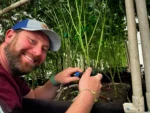Growing cannabis indoors with highly refined lighting, temperature, humidity, and irrigation systems requires choosing a growing substrate that accommodates a matching level of control and management.
This is why indoor cannabis growers typically choose soilless growing mediums for their potting mix rather than native soils, says Tad Hussey, founder of KIS Organics, an internet-based soil and gardening organic supply company and host of the popular Cannabis Cultivation Science podcast.
“When we talk about controlled environment agriculture, we want to have a substrate that allows us to have that same level of control that we’re getting from the other systems we have invested in,” Hussey says. “Because if we’re putting all this time and energy into lighting and HVAC and controlling our VPD (Vapor Pressure Deficit), then we also want to have a media or substrate that allows us to have good control over nutrient release to our plants.”
But there are many choices and considerations regarding the best growing media for your operation. BIOS Lighting’s cannabis team asked Hussey for his thoughts on the best substrate options for indoor cannabis growers and how growers can evaluate a new growing medium for their operation.
BIOS Lighting designs and manufactures LED lighting that maximizes photosynthesis and plant growth by focusing on the key ways lighting promotes a plant’s potential. BIOS Lighting was founded by former NASA scientists who developed the original technologies to provide light to grow crops in space.
Common Horticultural Substrates Used in Indoor Cannabis Production
There are multiple growing substrates cannabis growers may choose for their operation, depending on their goals, like organic versus chemical nutrients, and type of production methods, like hydroponic versus container-grown, Hussey says.
The most common substrates used in controlled environment agriculture, including cannabis, are:
- Rockwool: An extremely porous and lightweight substrate made from spun basalt rock fibers. Rockwool is a sterile, inert product containing no microbial populations or nutrients. It is often used in hydroponic systems as it supports rapid root growth that can access nutrients through chemicals introduced into the hydroponic system.
- Peat Moss: Fibrous brown material harvested from sphagnum moss peat beds. It does not contain noteworthy amounts of minerals but does have beneficial microbes, including disease-suppressing micro-organisms. Peat moss is typically blended with other products for a potting soil mix, which adds good aeration and moisture retention. Often used for organic production.
- Coco Coir: Made from the fibrous husk of a coconut. Holds onto moisture and nutrients while promoting a light and airy environment. Coconut is PH neutral versus other substrates, including peat moss, which are acidic. This makes it an excellent choice in a chemical nutrient program (non-organic) requiring a neutral base. Coco coir encourages beneficial bacteria populations and naturally releases phosphorus and potassium but can have a high sodium content.
- New Technologies: There are new emerging substrates that cannabis growers may want to try. PittMoss® is a branded soilless potting soil mix made from organic, recycled paper. HydraFiber®, made from refined wood and bark, is another newly-released branded soilless product.
Consider Sustainability When Choosing Your Substrate
Hussey encourages cannabis growers to consider sustainability when choosing a growing medium.
Not only are cannabis consumers demanding more environmentally-positive products, but a lot of the traditional substrates are single-use, driving up costs and reducing their sustainability.
“The traditional model in horticulture and in cannabis is at the end of the growth cycle you’re disposing of that media and starting over fresh. The idea is you have less pest pressure, better control over your substrate, and a multitude of other benefits,” Hussey says. “However, the labor associated with bringing media in and out of your facility is massive. The environmental impact of dumping these substrates, which can be full of phosphates, or in some cases, nitrates, into the environment has a damaging impact. And it’s just not cost-effective as we move towards running leaner cannabis operations.”
Rockwool does not break down; its dust and fibers can be harmful to human health and are the subject of a potential ban in the European Union, Hussey says. Coconut coir is often touted as being sustainable because it is a waste product of the coconut industry. However, making coir requires significant processing, creating health risks in the indigenous communities where it is produced. Shipping miles are also substantial for coconut coir.
Hussey prefers peat moss as the most sustainable option. Even though it is harvested from native peat bogs, there are still vast reserves of peat bogs. And most peat moss is harvested in Canada, close to the U.S. marketplace compared to coco coir.
“Ideally, cannabis growers should recycle, re-amend and reuse their media to improve the sustainability metrics of their grow media,”
Tad Hussey, CEO and Founder of KIS Organics, a BIOS Lighting distribution partner.
“So what we do specifically with growers is work on treating our media the same way we would agricultural soils by soil testing, by water testing, and then by re-amending that soil in the facility in place and starting up our next flowering cycle 24 to 36 hours later,” Hussey says, adding that they encourage growers to use a system of growing in beds, rather than pots because it allows them to mix nutrients right back into the substrate mix.
The Three-Legged Stool Method to Evaluating Cannabis Grow Media
Hussey subscribes to the “three-legged stool”’ philosophy when evaluating a new grow media. Growers need to consider a substrate’s physical, biological, and chemical (aka nutritional) characteristics when evaluating a new product line.
- Physical characteristics would be asking how well does that soil or substrate hold together? What kind of water retention, porosity, and aeration does it have? What type of gas exchange does it promote? (As a plant takes up oxygen, it releases carbon dioxide, this exchange of gasses occurs primarily through the growing medium).
- Biological characteristics include what sort of microbes are present and how conducive is the substrate to supporting a high level of microbial biomass. The rhizosphere microbial population is what cycles nutrients for plants, so their presence is critical to supporting vigorous growth, especially in organic production.
- Chemical characteristics are the analysis of the substrate’s nutritional components. Is it nutritionally balanced to the point that the plant has access to all the cations and ions it needs to be healthy and thrive?
Ultimately, however, fine-tuning the perfect growing media for a controlled environment cannabis grow requires the grower to make adjustments and pay careful attention to all the elements of their operation, Hussy says. It’s not just the substrate, but everything that supports plant growth, including the lighting, that must work together effectively.
“We have to be a detective in our own environment, really look at a plant and figure out what’s going on,” Hussey says. “Some of that is innate, and I’ve seen certain growers that can walk into a room and instantly key into what’s going on. Or, for myself, I have to slow down and take a step backwards and work through what is essentially a dichotomous key.”
A dichotomous key offers clearly defined options for an investigator (in this case the grower) to work through when analyzing a problem. When problems arise, a process of elimination can help growers identify the source of the issue, whether it’s a substrate problem or something else, like inadequate irrigation.
To learn more about KIS Organic’s experience with living soil in a controlled environment cannabis grow, check out their 2018 study. Or, to hear more about how BIOS Lighting’s LED Cannabis Grow Light system supports healthy indoor cannabis environments, reach out to one of our cannabis experts.


